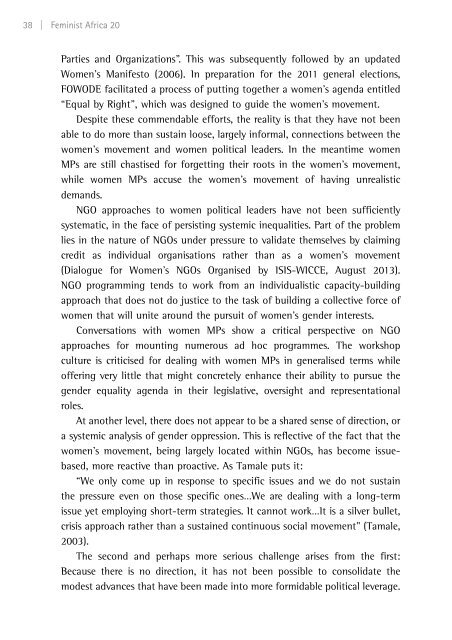You also want an ePaper? Increase the reach of your titles
YUMPU automatically turns print PDFs into web optimized ePapers that Google loves.
38 | Feminist Africa 20<br />
Parties <strong>and</strong> Organizations”. This was subsequently followed by an updated<br />
Women’s Manifesto (2006). In preparation for the 2011 general elections,<br />
FOWODE facilitated a process of putting together a women’s agenda entitled<br />
“Equal by Right”, which was designed to guide the women’s movement.<br />
Despite these commendable efforts, the reality is that they have not been<br />
able to do more than sustain loose, largely informal, connections between the<br />
women’s movement <strong>and</strong> women political leaders. In the meantime women<br />
MPs are still chastised for forgetting their roots in the women’s movement,<br />
while women MPs accuse the women’s movement of having unrealistic<br />
dem<strong>and</strong>s.<br />
NGO approaches to women political leaders have not been sufficiently<br />
systematic, in the face of persisting systemic inequalities. Part of the problem<br />
lies in the nature of NGOs under pressure to validate themselves by claiming<br />
credit as individual organisations rather than as a women’s movement<br />
(Dialogue for Women’s NGOs Organised by ISIS-WICCE, August 2013).<br />
NGO programming tends to work from an individualistic capacity-building<br />
approach that does not do justice to the task of building a collective force of<br />
women that will unite around the pursuit of women’s gender interests.<br />
Conversations with women MPs show a critical perspective on NGO<br />
approaches for mounting numerous ad hoc programmes. The workshop<br />
culture is criticised for dealing with women MPs in generalised terms while<br />
offering very little that might concretely enhance their ability to pursue the<br />
gender equality agenda in their legislative, oversight <strong>and</strong> representational<br />
roles.<br />
At another level, there does not appear to be a shared sense of direction, or<br />
a systemic analysis of gender oppression. This is reflective of the fact that the<br />
women’s movement, being largely located within NGOs, has become issuebased,<br />
more reactive than proactive. As Tamale puts it:<br />
“We only come up in response to specific issues <strong>and</strong> we do not sustain<br />
the pressure even on those specific ones…We are dealing with a long-term<br />
issue yet employing short-term strategies. It cannot work…It is a silver bullet,<br />
crisis approach rather than a sustained continuous social movement” (Tamale,<br />
2003).<br />
The second <strong>and</strong> perhaps more serious challenge arises from the first:<br />
Because there is no direction, it has not been possible to consolidate the<br />
modest advances that have been made into more formidable political leverage.


